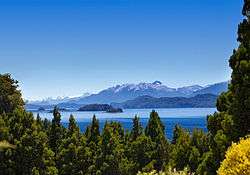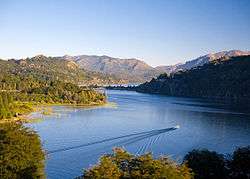Nahuel Huapi Lake
Nahuel Huapi Lake (Spanish: Lago Nahuel Huapí) is a lake in the lake region of northern Patagonia between the provinces of Río Negro and Neuquén, in Argentina. The tourist center of Bariloche is on the southern shore of the lake.
| Nahuel Huapi Lake | |
|---|---|
 | |
 Nahuel Huapi Lake | |
| Location | Los Lagos Department, Neuquén Province / Bariloche Department, Río Negro Province, Argentina, in Patagonia |
| Coordinates | 41°05′25″S 71°20′08″W |
| Type | Glacial lake |
| Primary inflows | Huemul river Correntoso river Bonito river Machete river |
| Primary outflows | Limay River |
| Basin countries | Argentina |
| Max. width | 6.3 miles (10.1 km) |
| Surface area | 205 sq mi (530 km2) |
| Average depth | 515 ft (157 m) |
| Max. depth | 1,522 feet (464 m) deeper places might exist |
| Water volume | 83.35 cubic kilometres (20.00 cu mi) |
| Shore length1 | 222 miles (357 km) |
| Surface elevation | 2,510 ft (770 m) |
| Islands | Isla Victoria Isla Huemul |
| Settlements | San Carlos de Bariloche Villa La Angostura |
| 1 Shore length is not a well-defined measure. | |
The June 2011 eruption of the Puyehue-Cordón Caulle volcanic complex, in neighboring Chile, caused parts of the lake's surface to be blanketed in volcanic ash.[1]
During the Last Glacial Maximum of the Llanquihue glaciation the lake basin was wholly occupied by a glacier.[2]
Etymology
The name of the lake derives from the toponym of its major island in Mapudungun (Mapuche language): "Island of Puma", from nahuel, "puma", and huapí, "island". There is, however, more to the word "Nahuel" - it can also signify "a man who by sorcery has been transformed to a puma".
Geography

.jpg)
Nahuel Huapi lake, located within the Nahuel Huapi National Park, has a surface of 530 km2 (200 sq mi), rests 2,510 feet (770 m) above the sea level, and has a maximum measured depth (as of 2007) of 1,522 feet (464 m).
The lake depression consists of several glacial valleys carved out along faults and Miocene valleys that were later dammed by moraines.
Its seven branches are named Blest (36 km²), Huemul (21.5 km²), de la Tristeza (18.5 km²), Campanario (7.9 km²), Machete, del Rincón and Última Esperanza. It is connected to other smaller lakes such as Gutiérrez, Moreno, Espejo and Correntoso. The deep-blue waters hold a number of islands, most notably Isla Victoria with an area of 31 km², and Isla Huemul.
A curious fact about the lake is that, despite being nowhere near any ocean and being at high altitude, it is also home for kelp gull and the blue eyed cormorant (Phalacrocorax atriceps), otherwise strictly marine birds.[3][4][5]
The lake’s crystal clear waters are very susceptible to climate changes and have an average surface temperature of 45 °F (7 °C); this makes it both beautiful and treacherous. Hypothermia is one of the risks bathers must undertake. Kayaking is a popular sport on this and adjacent lakes. The lake is also the starting point of the Limay River.
Fauna
This lake harbors several introduced, non-native species of trout,[6] including rainbow trout, brown trout and brook trout which attract anglers from the world over.
Nahuelito
At the beginning of the 20th century, and following an old aboriginal legend,[7] the rumor of a giant creature living in the deep waters of the lake took up. The creature is known locally as Nahuelito. Reported sightings of it predate Nessie and The Lost World (Arthur Conan Doyle).[8]
Local aborigines (Mapuche) called another creature el Cuero (leather) for its smooth skin. The neighboring lake Lago Lácar, has also been the site for accounts of another creature, more consistent with a plesiosaur, with aborigines describing it as a sea-cow with teeth all around it.
Members of the Buenos Aires Zoo visited the lake in 1922 trying to corroborate the reports of sightings of the prehistoric animal, but found no evidence to support the theory of such a creature.
Hitler conspiracy theory

In his 2004 book Bariloche nazi-guía turística, Argentine author Abel Basti claims that Adolf Hitler and Eva Braun lived in the surroundings of Bariloche for many years after World War II.[9] Basti said that the Argentine Nazis chose the estate of Inalco as Hitler's refuge.[9]
In his 2004 book Bariloche nazi-guía turística, Argentine author Abel Basti suggests that Hitler and Braun did not commit suicide, but actually escaped to Argentina. The scenario proposed by the two authors is as follows: a number of U-boats took certain Nazis and Nazi loot to Argentina, where the Nazis were supported by future president Juan Perón, who, with his wife "Evita", had been receiving money from the Nazis for some time. Hitler allegedly arrived in Argentina, first staying at Hacienda San Ramón, east of San Carlos de Bariloche.[9] Hitler then moved to a Bavarian-styled mansion at Inalco, a remote and barely accessible spot at the northwest end of Nahuel Huapi Lake, close to the Chilean border. Around 1954, Eva Braun left Hitler and moved to Neuquén with their daughter, Ursula ('Uschi'); and Hitler died in February 1962.[9][10][11][12]
Gallery
 Nahuel Huapi Lake
Nahuel Huapi Lake Sun over the Nahuel Huapi lake at 12:00 pm
Sun over the Nahuel Huapi lake at 12:00 pm Windy Nahuel Huapi
Windy Nahuel Huapi
See also
- Huemul Project, the Argentine secret research project on nuclear fusion on the Huemul Island.
- Limay River, a major river of the region that is born in the lake.
External links
References
- "Chilean volcano fills lake with ash". The Daily Telegraph. London. 16 June 2011.
- Heusser, C.J. (2004). Ice Age Southern Andes. Elsevier. pp. 25–29.
- "Blue-eyed Cormorant". Birdsoman.com. Retrieved 2013-01-02.
- "NAHUEL HUAPI NATIONAL PARK - ARGENTINA - National Parks in Argentina - Ripio Incoming Tour Operator Argentina". Ripioturismo.com.ar. 1903-11-06. Retrieved 2013-01-02.
- Pamela C. Rasmussen The Condor Vol. 88, No. 3 (Aug., 1986), pp. 393-395. University of California Press
- "La Fauna del Parque Nacional Nahuel Huapi". Bariloche.Org. Retrieved 2013-01-02.
- Sam Mustafa (25 November 2010). "The Myth of Nahuelito: A Monstrous Symbol of Argentina". Argentina Independent. Retrieved 3 March 2017.
- "Lake Monsters: Nahuelito". Strangemag.com. Retrieved 2013-01-02.
- "NAZI-GUÍA TURÍSTICA POR BARILOCHE". El Tiempo (in Spanish). January 2, 2004. Retrieved August 7, 2019.
- "FBI — Adolf Hitler Part 01 of 04 - File No 105-410". vault.fbi.gov. Retrieved 3 September 2014.
- "Hitler lived until 1962? That's my story, claims Argentinian writer". The Guardian. October 27, 2013. Retrieved August 7, 2019.
- Thope, Vanessa (October 27, 2013). "Hitler escape book's authors in plagiarism row". The Japan Times. Retrieved August 8, 2019.